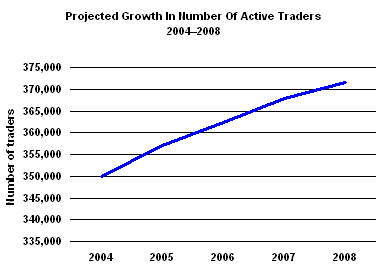Active Trader Update 2005: The Race For High-Revenue Clients Heats Up
Abstract
New York, NY, USA May 4, 2005Competition Heats Up As Active Trader Market SlowsCelent projects that there are approximately 350,000 retail active traders who trade 120 or more times per year. This market is projected to grow by 1 to 2 percent per year between 2005 and 2008. Active traders remain a key segment of the US retail brokerage market. Although they represent a relatively small part of the overall online investing population, they generate a large percentage of revenue tradesand profitsat most online brokerage firms. In a new report, , Celent provides an overview and analysis of key market trends, identifying leading industry players and discussing their prospects for future growth in the mass active trader segment. After investing in technology to handle pre-2000 trade volumes, online brokerage firms find themselves saddled with excess capacity. At the same time, commissions have faced steady downward pressure and Celent projects that commissions will continue to decline. The one bright spot is that profitability per trade at most firms has actually increased as result of greater efficiency in trade execution, clearing, and settlement; this makes active traders all the more attractive as a customer segment. In an attempt to attract and retain their active trader clients, firms have undertaken several rounds of price cuts over the past 12 years, and continue to invest in a sophisticated array of tools and services designed to support the active online trader.  "The online retail brokerage firms are struggling to retain and grow their share of the active trader market," says Lauren Bender, analyst in Celents Securities & Investments group and author of the report. "It appears that recent price cuts have not succeeded in growing the overall market, and thus firms continue to compete among themselves for the limited number of existing active traders. With the current overcapacity in the market and the high cost of serving active trader clients, we expect that this industry will move to consolidate over the next 1824 months." In spite of current and future price cuts and costly product enhancements, the active trader segment remains very attractive to online brokerage providers. While overall retail trading activity has not returned to 2000 levels, active traders have returned to the market in greater numbers than other retail investors. Active trader volumes now account now for more than 50 percent of all retail trades at larger firms such as Charles Schwab. The growing importance of active traders relative to other traders has been a steady trend since late 2001, and firms are doing everything in their power to hold on to their share of this lucrative business and to lure active traders away from competing firms. The firms discussed in the report are Ameritrade, BrownCo, Charles Schwab, E*TRADE, Fidelity, optionsXpress, Scottrade, TD Waterhouse, and TradeStation. The 33-page report contains 13 figures and three tables. A table of contents is available online. |
of Celent Communications' Retail Securities & Investments research service can download the report electronically by clicking on the icon to the left. Non-members should contact info@celent.com for more information. |
|

